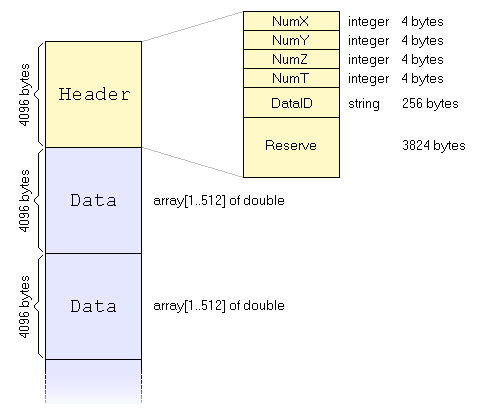
Home  Technical Documentation Technical Documentation  Data Formats Data Formats  Data Cube Data Cube |
||
See also: Metadata, Data Model, Overview, SetCubeCell, GetCubeCell
 |
||
The Data Cube |
||
|
The data is stored in two files, a binary file containing the actual data (the pure numbers, file extension .cube) and a text file containing the metadata (which provides information about the interpretation of the pure numbers, file extension .ilab). The data cube ("pure numbers") is organized as a 4-dimensional cuboid of arbitrary side lengths. The individual data values are always 64 bit (double precision) floating point numbers according to the IEEE-754 standard. The data cube's internal structure consists of a four-dimensional array of floating point numbers: data : array[1..NumT, 1..NumL, 1..NumY, 1..NumX] of doublewith NumX, NumY, NumL, and NumT specifying the number of the cube's cells along the X, Y, L (layer) and T (time) axis.
Data Cube FileThe figure below shows the organisation of the binary file. The file is organized in records of 4096 bytes to ensure maximum transfer speed to/from the disk. The first record serves as a header containing the minimum information to ensure correct reading of the data (see below). All following records contain linear arrays of 512 IEEE-754 double precision values each.
const
BINDATARECSIZE = 512; // size of binary data record = 4096 bytes
type
T4DData = array of array of array of array of double;
TDataRec = array[1..BINDATARECSIZE] of double;
THeadRec = record //has to be of same size as TDataRec
NumX : integer; // 4 bytes
NumY : integer; // 4
NumL : integer; // 4
NumT : integer; // 4
DataID : string[255]; // 256 bytes
Reserve: array[1..3824] of byte; // rest to fill up
end;
TMetaTags = (mtDatetime, mtVersion, mtSizeX, mtSizeY, mtSizeL, mtSizeT,
mtDescription, mtAuthor, mtAxidX, mtAxidY, mtAxidL,
mtAxidT, mtDataCRC, mtCertiFree, mtPropsX, mtPropsY, mtPropsT, mtPropsL,
mtSampleID, mtPhotos, mtMaskNames, mtFileType, mtTilePos, mtLayerTecDat,
mtLinkedFiles, mtPixAttNames, mtPixAttribs);
const
SAMPLEID = 'This is my best sample';
METAVERSION = 4; // current format version number of metadata (*.ilab)
METATAGS : array[TMetaTags] of string =
('datetime', 'version', 'sizex', 'sizey', 'sizel', 'sizet',
'description', 'author', 'axidx', 'axidy', 'axidl', 'axidt',
'datacrc', 'certificate', 'propsx', 'propsy', 'propst', 'propsl',
'sampleid', 'photos', 'maskids', 'filetype', 'tilepos',
'layertecdat', 'linkedfiles', 'pixattnames', 'pixattribs');
The DataID parameter is a string containing arbitrary additional information which is currently not used by Epina ImageLab but may be used in future releases.
Sample Pascal codeThe following Pascal code shows how to store the binary data. The data source is a 4-dimensional array which is stored in a file is given by the parameter FName. DataID should be an empty string (do not use it).
(******************************************************************************)
procedure SaveCubeDataOnFile (FName: string; DataID: string);
(******************************************************************************)
var
ix : integer;
m,k,j,i : integer;
poi : integer;
OFile : file of TDataRec;
DataRec : TDataRec;
HeadRec : THeadRec;
cnt : int64;
step : int64;
NumX : integer;
NumY : integer;
NumL : integer;
NumT : integer;
begin
NumT := length(Data); // get the dimensions of the data matrix
NumL := length(Data[0]);
NumY := length(Data[0][0]);
NumX := length(Data[0][0][0]);
assignfile (OFile, FName);
rewrite (OFile); // open file for write
for ix:=1 to BINDATARECSIZE do // reset data record
DataRec[ix] := 0;
HeadRec.NumX := NumX; // fill the header
HeadRec.NumY := NumY;
HeadRec.NumL := NumL;
HeadRec.NumT := NumT;
HeadRec.DataID := DataId;
write (OFile, TDataRec(HeadRec)); // write header record
poi := 0; // now fill and write data records
cnt := 0;
step := round(1.0*NumT*NumL*NumX*NumY/100);
for m:=1 to NumT do
for k:=1 to NumL do
for j:=1 to NumY do
for i:=1 to NumX do
begin
inc (cnt);
if cnt mod step = 0 then
FrmSaveCube.PBar1.Value := cnt/step;
if poi < BINDATARECSIZE
then begin
inc(poi);
DataRec[poi] := Data[m-1,k-1,j-1,i-1];
end
else begin
write (OFile, DataRec); // write data record
poi := 1; // reset buffer pointer
DataRec[poi] := Data[m-1,k-1,j-1,i-1];
end;
end;
write (OFile, DataRec); // save the last (partially filled) data record
closefile (OFile); // close file
end;
After saving the actual data on the disk you have to store the meta information as well. The meta information is stored in a file with the same filename as the binary data cube but with a file extension '.ilab'. The metadata file is a text file using keywords which are defined in the constant array METATAGS (see above). The exact specification of the format of each meta tag can be found in the description of the meta tags.
(******************************************************************************) procedure SaveMetaDataOnFile (FName: string; NumX, NumY, NumL, NumT: integer; DataID: string); (******************************************************************************) // Please note: in order to make things simple most of the meta information // is hard-coded in the following code. Of course, this has to be resolved // in a non-example routine. var OFile : TextFile; i,j : integer; DestDir : string; OldPath : string; astr : string; begin DestDir := ExtractFilePath(FName); assignfile (OFile, FName); FileMode := fmOpenReadWrite; rewrite (OFile); // required meta tags.... // The following tags are required by Epina ImageLab for proper functioning // format version tag writeln (OFile, '\', METATAGS[mtVersion], ' ', IntToStr(METAVERSION)); // specification of data cube size writeln (OFile, '\', METATAGS[mtSizeX], ' ', IntToStr(NumX)); writeln (OFile, '\', METATAGS[mtSizeY], ' ', IntToStr(NumY)); writeln (OFile, '\', METATAGS[mtSizeL], ' ', IntToStr(NumL)); writeln (OFile, '\', METATAGS[mtSizeT], ' ', IntToStr(NumT)); // scale properties of the axes writeln (OFile, '\', METATAGS[mtPropsX], ' 1'); // x axis writeln (OFile, '1;',NumX,':: 1.0 0.0; 1.0 0.0:N::px'); writeln (OFile, '\', METATAGS[mtPropsY], ' 1'); // y axis writeln (OFile, '1;',NumY,':: 1.0 0.0; 1.0 0.0:N::px'); writeln (OFile, '\', METATAGS[mtPropsL], ' 1'); // layer (wavelength) writeln (OFile, '1;',NumL,':uvvis: 1.0 400.0; 1.0 -400.0:N:1:nm'); writeln (OFile, '\', METATAGS[mtPropsT], ' 1'); // timeslots writeln (OFile, '1;',NumT,':: 1.0 0.0; 1.0 0.0:N::'); // additional tags... // the following tags are optional and are mainly used to // describe the data writeln (OFile, '\', METATAGS[mtDateTime], ' ', FormatDateTime ('yyyy-MM-dd HH:mm:ss.sss', Now)); writeln (OFile, '\', METATAGS[mtDescription], ' ',IntToStr(2)); writeln (OFile, 'Description Line 1 |
||



